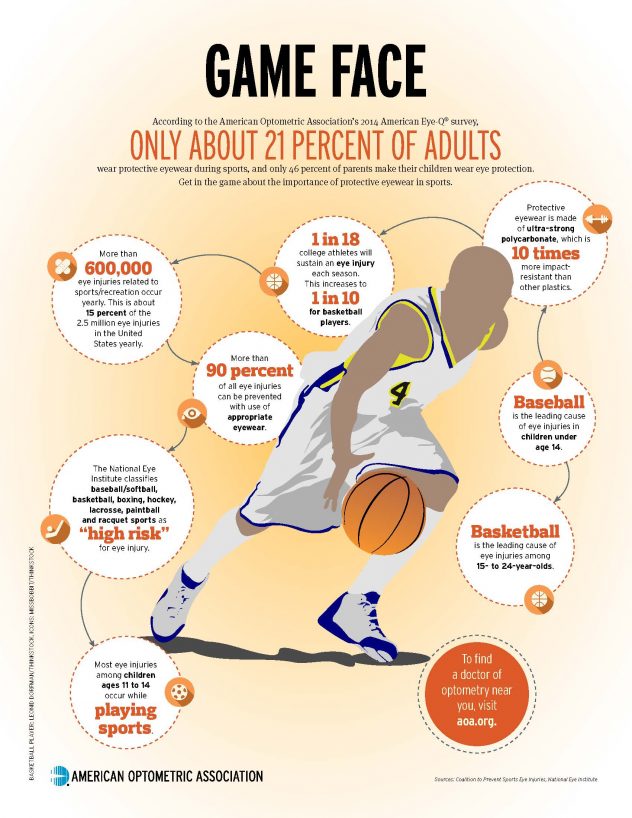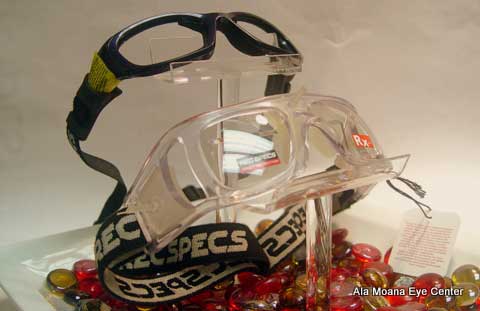- The National Eye Institute classifies baseball/softball, basketball, boxing, lacrosse, hockey, paintball and racquet sports as “high risk” for eye injury.
- More than 600,00 related to sports/recreation occur every year. This is about 15% of the 2.5 million eye injuries in the United States yearly.
- 1 in 18 college athletes will sustain an eye injury each season. This increases to 1 in 10 for basketball players.
- Basketball is the leading cause of eye injuries among 15 to 24 year old.
- Baseball is the leading cause of eye injuries in children under 14 years old.
- Most eye injuries among children ages 11 to 14 occur while playing sports.
- More than 90% of all eye injuries can be prevented with the use of protective eye wear.
- Protective eye wear is made of ultra-strong polycarbonate, which is 10 times more impact resistant than other plastics.
Category: Protective Eyewear
Proper Eyewear and Healthy Vision Crucial for Athletes’ Performance
As athletes gear up for a game, a vital component must be on their checklists—eye protection. Although extremely important, eyewear isn’t always a priority for some. According to the American Optometric Association’s (AOA) 2014 American Eye-Q® consumer survey, only 21 percent of those surveyed wear protective eyewear when playing contact sports. Athletes also need to be sure their eye health and vision are at their best—after all, a player’s vision could be the difference between their team’s win or loss.
Dr. Tracie Inouchi can recommend appropriate eye protection for athletes and ensure their vision is sharp for the game.
Liberty Optical Safety Eyeglasses
What sports are considered high-risk for eye injury?
Sports considered by the National Eye Institute to be high-risk for eye injuries include baseball, softball, basketball, hockey, and racquetball. Basketball, in particular, has been ranked as a leading cause of eye injuries among 15- to 24-year-olds.
Tips to prevent serious eye injury
To prevent injury, athletes are advised to wear eye protection that may include safety glasses and goggles, safety shields, and eye guards designed for a particular sport and that meet American Society for Testing and Materials (ASTM) standards. These types of protection are designed to be impact resistant without clouding an athlete’s vision. Dr. Inouchi can advise a patient athlete, coach, or parent on the best protection for that athlete and his or her needs.
UV protection is also important to consider, as exposure to UV radiation without proper protection can lead to serious problems.
“Short-term exposure to UV rays could lead to photokeratitis, also known as ‘sunburn of the eye,’” said Dr. Inouchi. “Symptoms of photokeratitis include red eyes, a foreign-body sensation or gritty feeling in the eyes, extreme sensitivity to light and excessive tearing. Long-term exposure to UV can cause damage to the eye, possibly resulting in cataracts, age-related macular degeneration, or other visual impairments.”
For optimal eye sun-safety, the AOA recommends wearing sunglasses that block out 99 to 100 percent of both UV-A and UV-B rays. Click here to learn more about UV protection.
Be prepared for an injury
Those on the sidelines need to keep an ocular emergency first aid kit on the bench so eye trauma can be dealt with swiftly and properly.
“A kit should include saline solution to ‘flush out’ an athlete’s eyes and a penlight with a blue filter and fluorescein dye to detect foreign bodies,” said Dr. Inouchi. “Coaches should also have an ocular emergency triage card on hand so they know when it’s time to visit the optometrist for an eye injury.”
Click here to download an ocular emergency triage card from the AOA Sports Vision Section, which works year-round to advance the quality and delivery of optometric sports vision care.
By visiting Dr. Daniel Yamamoto & Dr. Tracie Inouchi regularly for comprehensive eye care, athletes can perform their best on the court or field with clear and healthy vision, as well as be sure their eyes are protected and, hopefully, bring home a win.
To make an appointment with Dr. Daniel Yamamoto & Dr. Tracie Inouchi for a comprehensive eye exam, call 808.949.2662
Five Tips For a Lifetime of Healthy Vision
Here are 5 tips for a life time of healthy vision. Honolulu eye doctors, Daniel Yamamoto, O.D. and Tracie Inouchi, O.D. suggest:
- Schedule Yearly Comprehensive Exams. Seeing a doctor of optometry regularly will help keep you on the path to healthy eyes.
- Protect against UV rays. No matter the season its important to wear sunglasses.
- Give your eyes a break from digital device use. Practice the 20/20/20 rule: every 20 minutes take a 20 second break and look at something 20 feet away.
- Eat your greens. Eat five servings of fruits and vegetables – particularly the leafy green variety.
- Practice safe wear and care of your contact lenses. Keep them clean.

Did You Know?
Did You Know?
- 80 percent learning happens through your child’s their eyes.
- Until the teenage years, a child’s crystalline lens does NOT prevent UV light from damaging the retina.
- School vision screenings may not detect all vision problems in kids.
- 1 child out of 4 does not see well in school.
- 600,000 eye injuries related to sports and recreation occur each year. Are your child’s eyes protected?
Now You Know.
Custom Prescription Oakley M Frame – Hybrid
This custom piece was designed for:
- The active sports enthusiast who needs prescription eyeglasses.
- Protective sports eyewear with an impact resistant lens and durable frame.
- A sleek and sporty look unlike that of your typical sports goggles.

This frame has the added flexibility of a removable shield. The shield can be removed and replaced with a standard (non-prescription) M Frame sunglass shield.

Custom Oakley M Frame Hybrid with a prescriptive lens inset into the M Frame shield



